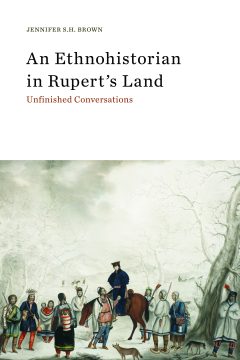Canada west of the Great Lakes was for centuries a blank space on the map, as dark and foreboding as the heart of Africa. Canadians have only anecdotal records of the era of vast buffalo herds, passenger pigeons that blocked out the sun, and volcanoes that leveled Nisga’a settlements in British Columbia.
We don’t even know what ancient Canada looked like, writes historian Jennifer Brown. The remotest districts today have been forever altered by settlement, industrial farming and hydroelectric dams.
Brown is a former Chicagoan who taught for decades at the University of Winnipeg’s Department of History. She rated herself lucky; the Hudson’s Bay Company archives were just down the street. In An Ethnohistorian In Rupert’s Land, Brown chronicles her attempts to piece together a glimpse of early Canada. Brown’s enthusiasm is infectious.
Rupert’s Land was a mammoth territory from James Bay to the foothills of the Rockies assigned to fur traders by royal charter in 1670. “It is almost invisible in most North American histories,” she writes; “I have become more aware of what we do not know.”
Imagine historians five centuries from now attempting to piece together our own time, says Brown: “McDonald’s hamburger restaurants and competing chains are widely distributed across North America, as trading posts once were. They are pervasive and predictable in their appearance, their personnel and offerings, and in the economic transactions and social activities that go on inside.”
“Suppose that some future historian decides to designate a part of North American history as ‘the hamburger era.’ Surely anyone doing so (we must hope) would have missed a vast range of other contemporary cultural, social and economic activities. A similar danger exists for the history of the fur trade.”
Professor Brown follows the threads, acknowledging the shortcomings of the documentary record. Indigenous peoples did not keep diaries, settlers and explorers did. “A key problem with these sources is that, with rare exceptions, they all spring from people of European origin who, even if they were not themselves traders, were enmeshed in the dynamics of biases that have been well recognized – and even overstated, in some instances,” writes Brown.
An Ethnohistorian In Rupert’s Land provides compelling vignettes in an attempt to colour in the blank space on the map. Brown traces the origins of the pejorative “squaw,” a term rarely used in the 18th century but popularized in subsequent years.
She profiles Thomas James, the English explorer immortalized in the naming of James Bay, who spent an entire winter on the Bay and “never met or saw an Aboriginal person,” writes Brown. And readers learn of Abishabis, a prophet of the Cree First Nation who singlehandedly led a pseudo-Methodist revival in 1842 that made the woods “ring with music” and told followers of his visions of “the track to heaven.”
An Ethnohistorian In Rupert’s Land is discovery of a vanished land.
By Holly Doan
An Ethnohistorian in Rupert’s Land: Unfinished Conversations, by Jennifer S.H. Brown; Athabasca University Press; 420 pages; ISBN 9781-7719-91711; $44.95






